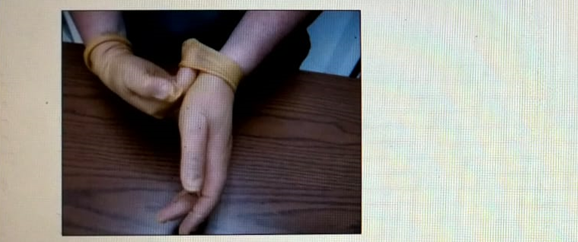As seen in the picture, the practical nurse (PN) begins to remove a pair of sterile gloves after changing a client's dressing. Which action should the PN take next?

Move away from the overbed table.
Pull glove down, keeping inside out.
Loosen the glove from the fingers.
Raise the hands above waist level.
The Correct Answer is B
A. Move away from the overbed table: This action can be done after the gloves are completely removed and disposed of. Moving away too early increases the risk of bumping into something and contaminating the gloves.
B. Sterile gloves are contaminated on the outside after performing a procedure like a dressing change. Pulling the glove down and everting it (turning it inside out) confines the contamination to the inside of the glove, reducing the risk of transferring germs to the hands or surrounding surfaces. This maintains a sterile field and minimizes the risk of healthcare-associated infections (HAIs).
C. Loosen the glove from the fingers: This might be the initial step while grasping the glove for removal, but the key is to maintain aseptic technique by keeping the outside of the glove contained throughout removal.
D. Raise the hands above waist level: Raising hands above the waist level increases the risk of contaminating the sterile field or nearby surfaces if the glove integrity is compromised.
Nursing Test Bank
Naxlex Comprehensive Predictor Exams
Related Questions
Correct Answer is {"A":{"answers":"B"},"B":{"answers":"C"},"C":{"answers":"A"},"D":{"answers":"C"},"E":{"answers":"A"}}
Explanation
Coarse breath sounds are typically associated with respiratory distress, indicating fluid or secretions in the airways.
Irritability can be a sign of both cerebral edema and respiratory distress as it may stem from hypoxia or increased intracranial pressure.
Seizure activity is more specifically related to cerebral edema, which can increase intracranial pressure and provoke seizures.
Decreased level of consciousness can occur in both conditions: cerebral edema (due to increased intracranial pressure) and respiratory distress (due to hypoxia).
Bradycardia is more indicative of cerebral edema, especially when associated with increased intracranial pressure and resultant autonomic dysregulation.
Correct Answer is A
Explanation
A. Increased oxygen saturation indicates that the Venturi face mask is effectively delivering the specified concentration of oxygen. This is the primary goal of using a Venturi mask, which provides precise oxygen delivery to improve oxygen saturation levels.
B. Increased cough productivity is not a direct indicator of the effectiveness of a Venturi face mask. The mask's purpose is to deliver oxygen, not to alter cough patterns.
C. Decreased cough frequency is unrelated to the function of the Venturi face mask. The mask's effectiveness is measured by oxygen delivery rather than changes in cough frequency.
D. Decreased breath sounds are not a direct measure of the effectiveness of a Venturi face mask. Breath sounds could indicate other respiratory issues but do not specifically reflect the effectiveness of oxygen therapy.
Whether you are a student looking to ace your exams or a practicing nurse seeking to enhance your expertise , our nursing education contents will empower you with the confidence and competence to make a difference in the lives of patients and become a respected leader in the healthcare field.
Visit Naxlex, invest in your future and unlock endless possibilities with our unparalleled nursing education contents today
Report Wrong Answer on the Current Question
Do you disagree with the answer? If yes, what is your expected answer? Explain.
Kindly be descriptive with the issue you are facing.
